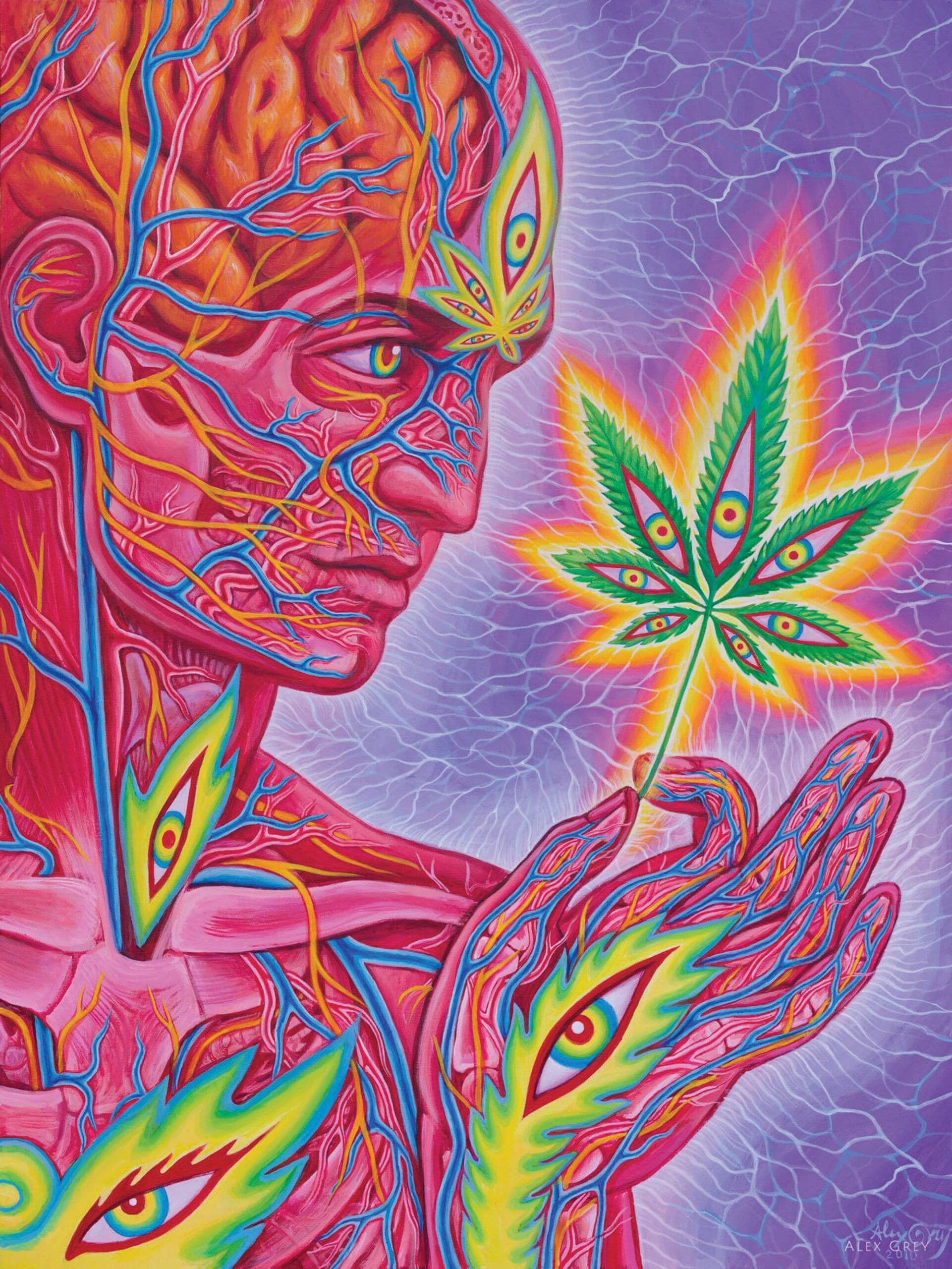The Leaf gets inside the heads of visionary art power couple Alex Grey and Allyson Grey to find out what effects Cannabis and psychedelics have had on their art, spiritual beliefs, and lives.
Since its emergence in the late 1960s, psychedelic culture has continued to grow, evolve, and express itself – primarily through music and art. And over the past few decades, no psychedelic artists have achieved higher notoriety or had a more meaningful impact on our culture than Alex and Allyson Grey.
Best known to many through his collaborations with the progressive metal band Tool, Alex’s art is a spectacular synthesis of love, light, birth, death, rebirth, and beyond. His imagery penetrates the psycho-spiritual strata of existence – peeling back the superficial surfaces and exposing the auras and energies that surround us, vibrating and pulsating when viewed through one’s third eye.
The same is true of his soulmate, Allyson. In contrast to Alex’s anatomical style, Allyson’s art is abstract – tapping into the sacred geometry of the cosmos to utilize fractals, symbols, and mathematical patterns to develop her own secret, sacred language. Together, they comprise a psychedelic power couple regarded by many as spiritual leaders with almost cult-like status.
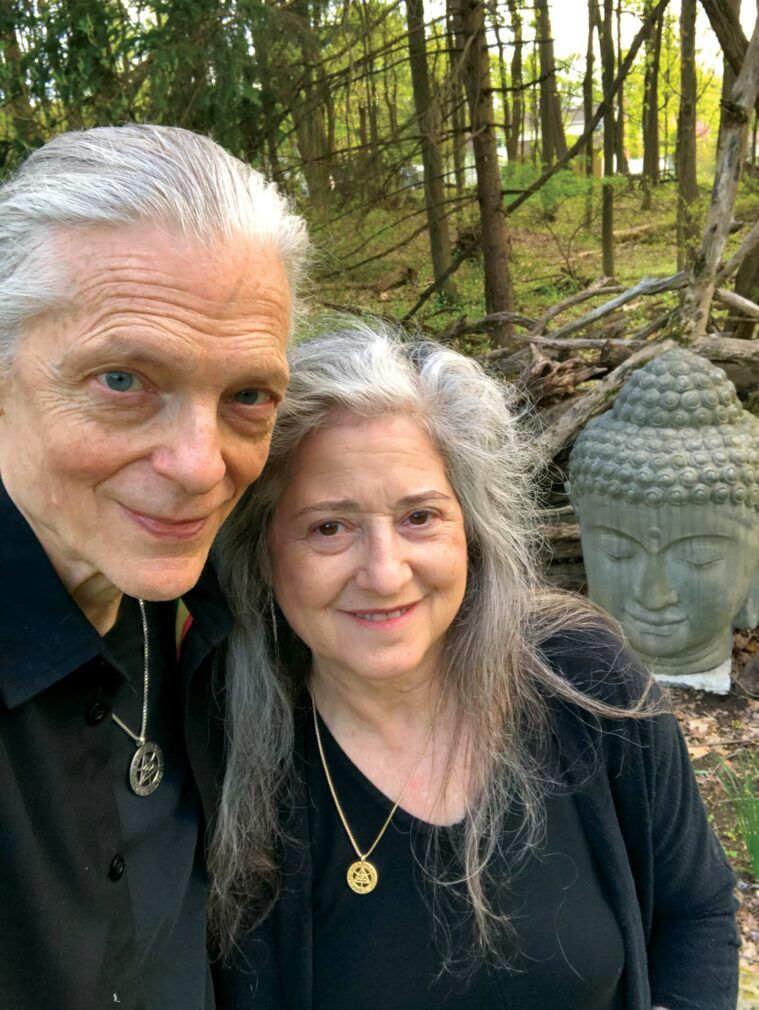
I first met the Greys at the Cannabis Cup in 1998, and our paths have continued to cross ever since. I attended one of their earliest Full Moon gatherings at their apartment in Brooklyn, blazed with them in Amsterdam, tripped out in their tent at Burning Man, and visited the Chapel of Sacred Mirrors, or CoSM – their temple/art gallery in NYC – countless times. Yet, I’d never had the pleasure of interviewing them … until now.
Tell us about your personal histories, your childhood, and your family life.
Our backgrounds are both different and similar. Both sets of parents married once and stayed together, embracing and practicing monogamy throughout their lifetimes. Both sets of parents worked throughout their lives, made a decent living, and died natural deaths at an advanced age. We both feel fortunate in having the opportunity of a good education. Our parents loved us and were supportive, yet not hovering or over-indulgent. Alex grew up in the faith of Christian Methodism; Allyson’s tradition was Reformed Judaism, an American Jewish movement of immigrants in the late 1800s.
Was your desire to become an artist innate, or did something happen in your life that made you consciously decide to become an artist?
Allyson: Teachers and peers recognized both of us, at an early age, as artists. That foundational encouragement gave us our artistic identities. Growing up, we both won awards for our art, exhibited our work, and were leaders in school.
Alex: My father introduced me to drawing as an infant. I would watch faces and creatures emerge from the tip of his pencil, and I’d dance in amazement. He activated something that may have been part of my past lives. My mother was a homemaker who loved me unconditionally after being the only woman in the business school at Ohio State University.
What jobs did you have before you became a professional artist?
Alex: My first job was painting funhouses. After two years of art school, I took a break for a year to work for Columbus Outdoor Advertising painting billboards. I saved money from that job to move to Boston and attend the Museum School, after which I took a job as a museum preparator at the Warren Anatomical Museum and the Mind Body Institute at Harvard Medical School. I left Harvard to work as a freelance medical illustrator for twelve years.
Allyson: I worked at my parents’ summer camp as a counselor and head staff member, teaching art and painting backdrops. After graduating with an MFA degree, I worked as an events coordinator for arts organizations and Executive Director for the Art Directors Club. Moving to New York, I became Alex’s illustrations rep and business manager.
How did you meet and fall in love?
Alex: We met in art school in 1974, in a class on Performance Art, Mixed Media, and Conceptual Art. Throughout art school, we continued to create performance installations and paint collaboratively.
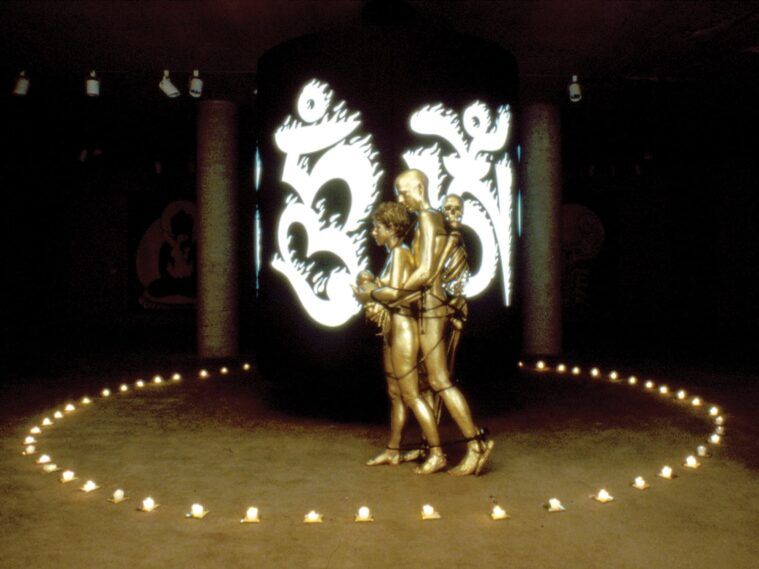
Your work has inspired a great many people … but who inspired you?
Allyson: As chairman of my high school prom, the theme was psychedelic. Creating art installation experiences captured me. As early as high school, abstract expressionists Jackson Pollack and Helen Frankenthaler influenced me, as well as minimalist Sol Lewitt and mixed media creator Lucas Samaras.
Alex: Michelangelo was always my favorite artist. As a youth, I admired Andrew Wyeth. As an art student, I was turned on by the Viennese Actionists. After taking LSD, I discovered visionary artists who drew inspiration from psychedelic experience, like Ernst Fuchs, Mati Klarwein, William Blake, and Jean Delville. But Allyson has been the most inspiring and influential artist in my life.
You’re both described as visionary artists. What does that term mean to you?
Alex: Visionary art is art that comes from inner visions and is often associated with the inspiration of psychedelic and mystical experiences.
Describe your creative process.
Allyson: Individually, we draw and paint after much planning and thought. We create performance installations together through discussion, drawing, and planning.
Did you have any formal art training, or are you self-taught?
Alex: All artists are self-taught. We both had fine art school educations, meaning endless hours of drawing and design classes followed by critiques and reviews of our work. I went to Columbus College of Art & Design and the Boston Museum School as a billboard painter with big brushes and gallons of oil paint creating 40-foot “spectaculars.” At the Museum School, I studied Performance Art and Mixed Media—the class in which I met Allyson. Studying independently, I read art magazines and was influenced by photo realists and performance artists.
Allyson: At the Boston Museum School, I studied mixed media where content was more important than materials. I got a Master of Fine Arts degree from Tufts University, a fifth-year certificate from the Museum School, and taught as a Fellow at both institutions.
It’s often said that the best art arises from suffering … does that adage hold any truth for you?
Alex: Buddhism teaches that life is suffering. Everyone suffers. We love our life – the highs and the lows. My art has embraced hopefulness as well as depression and difficult challenges, both personal and global.
Allyson: My art reflects an inner world – a spectral psychedelic vision and an essentialized worldview that is both bright and dark.
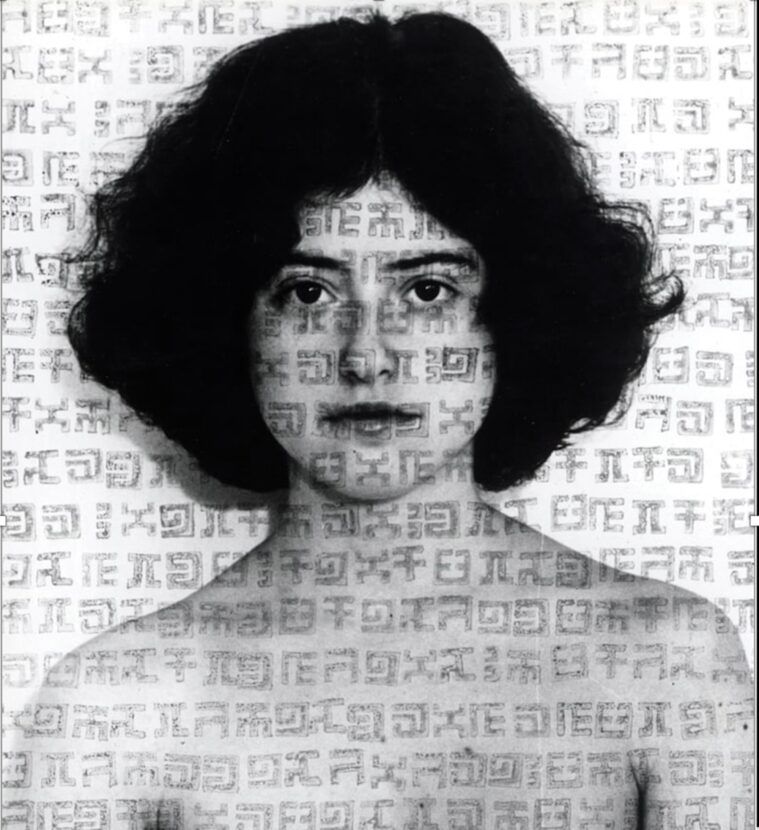
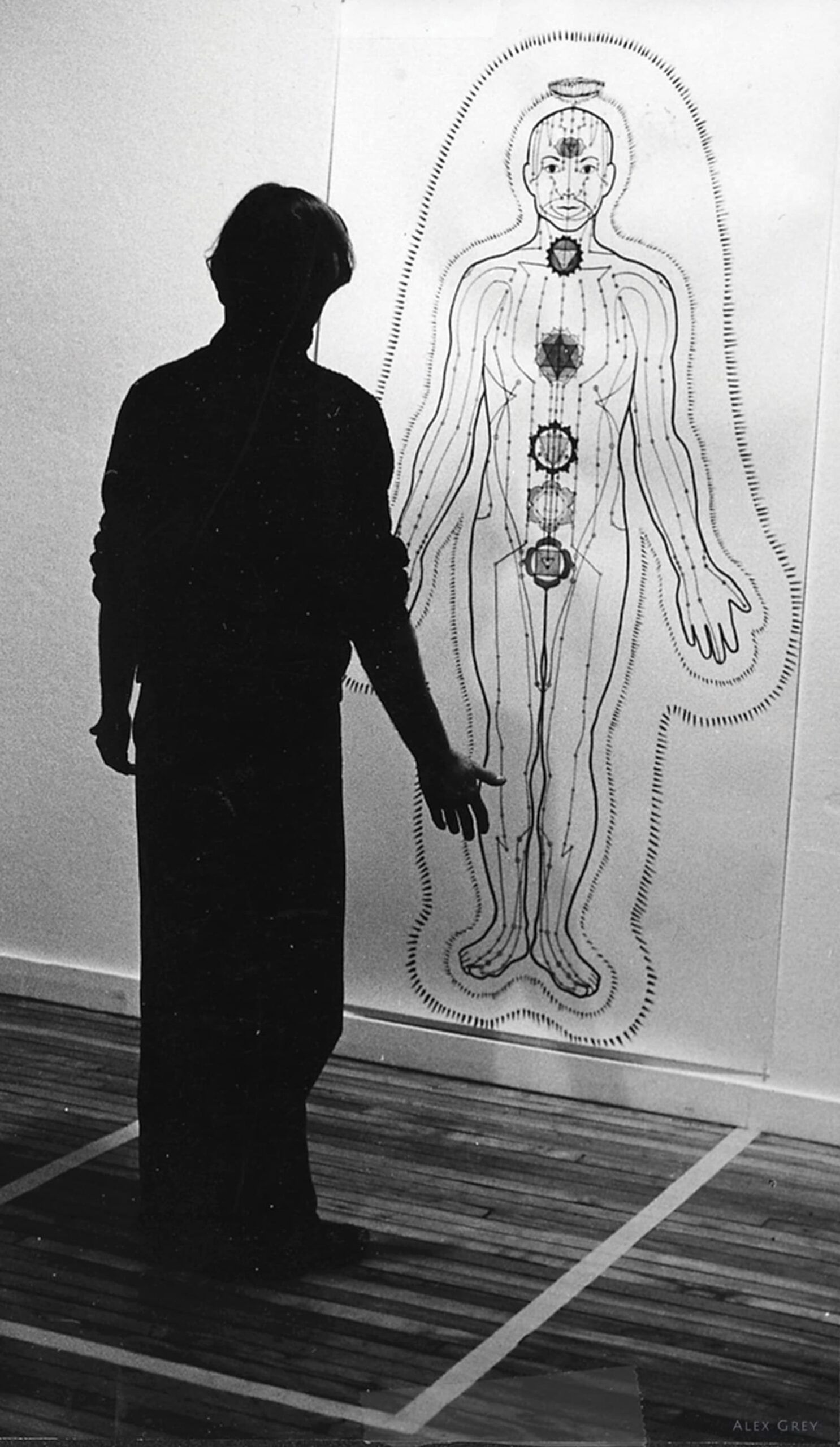
Is your art simply a matter of self-expression, or do you feel there’s a mission behind it?
Alex: I wrote a book called The Mission of Art that examines the paths of creativity and spirituality. The artist can be a spiritual emissary working in any medium in any part of culture. Mission connotes personal, passionate commitment to something. Mission is applied vision. Our art reflects an ineffable inner world. Its mission is to touch a great many people… a Net of Beings.
Allyson: Being artists fulfills our identity and is simply who we are. The best life is one that is fully self-expressed.
Alex – your work has reached a broader audience thanks to your collaborations with Tool. Tell us a little about that relationship.
Alex: Adam Jones came to my 1999 exhibit in a Santa Monica gallery, and we became friends. Adam invited my work to be part of three amazing albums: Lateralus, 10,000 Days, and the astonishingly prescient Fear Inoculum. Over the past 21 years, I’ve designed stage sets, music video collaborations, posters, and merchandise to accompany their tours … I even painted a drum set for Danny Carey. The members of Tool and their fans have been some of the greatest forces in supporting CoSM. Inside Entheon is a Tool Shrine with some cool relics, including a bronze sculpture by Adam, samples of Maynard’s wines, a wrap of the drum design, and many photos, posters, and preliminary drawings for the art that became associated with Tool. They are masterful musicians and it’s been an inspiration to work with them.
Describe your first experience with Cannabis.
Allyson: My sister and her friend got me stoned just before I went off to college at age 17. It was unpleasant, and I had to sleep it off. Almost as soon as I left home, I moved out of my dorm room and into an apartment with hash dealers. We smoked every day, and I remember laughing my ass off listening to Firesign Theater.
Alex: At 18, on my way to my first music festival featuring Mountain and Traffic.
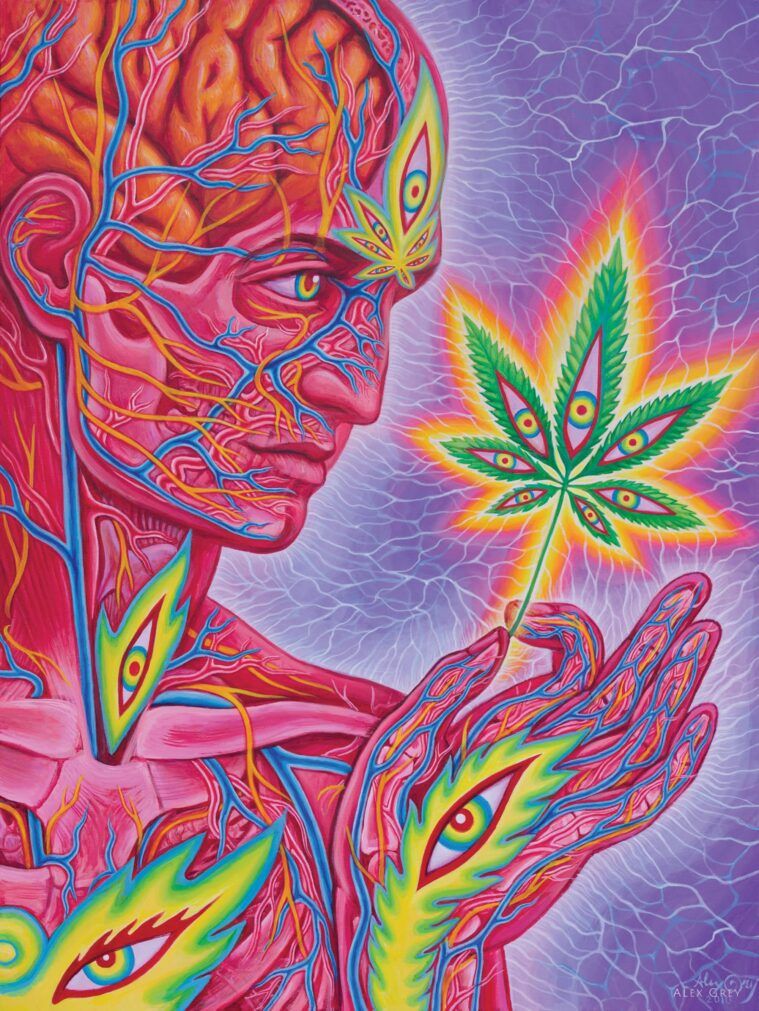
How often do you use Cannabis? Is it a part of your creative process?
Alex: Until Covid, we used it daily and often. It has been part of our creative process, but we’ve also created art stone-cold sober for years at a time.
Alex: Twice over the past 25 years, you painted the official art for the High Times Cannabis Cup, first “Cannabia” (cannabis goddess) in 1995, and over a decade later, her male counterpart, “Cannabacchus.”
Can you tell us how these two divinities occurred to you?
Alex: Cannabia was inspired by my goddess, Allyson, who posed for it. Cannabacchus was suggested by Allyson. The image of Cannabacchus was inspired by ganga smoking Babbas and the Green Man.
When did you first try psychedelics? Which drug was it, and what was your experience like?
Allyson: My first trip was at age 17 on the campus of NYU with my high school boyfriend. It was supposedly mescaline in pill form, but I suspect it was actually LSD. We walked about 70 blocks down 5th Avenue talking about our experiences and life. After that, I was privileged to experience LSD regularly and often for about three years – Orange Sunshine, Purple Haze, Owsley acid, and others. Once, having taken too much MDA, I recall sitting in the front row for the premiere of 2001: A Space Odyssey and shaking uncontrollably. Being carried from the theatre by my boyfriend, I reassured him and knew that I would be okay.
Alex: My first trip was in Allyson’s apartment in 1975. Wary of my mental health, I waited until I was 21. That day I had asked God to give me a sign that I should go on living. That evening on the way to Allyson’s party, I was offered LSD mixed into a bottle of Kahlua. I drank half the bottle and when Allyson met us at the door, I handed her the other half of the bottle. I sat for hours, not speaking to anyone, envisioning a pearlescent spinning tunnel. I was in the dark, spiraling toward the light. The light was God, and that became my path. It was my first night with Allyson – that has lasted all these years.
Which psychedelics have you tried? Which do you like the most and why?
Alex: LSD has always been our favorite psychedelic. It offers the longest and most visual journey. We’ve enjoyed many psilocybin experiences and have participated in numerous ayahuasca ceremonies in the past few decades.
Also, ketamine journeys were a regularly experienced event for a few years, administered in our home. We were privileged to share one experience with Allyson’s mother, our only opportunity to share an altered state with a parent. The experience of injected ketamine has been described accurately as feeling like an effervescent tablet (Alka-Seltzer) being dropped into water. It is not colorful like LSD or psilocybin, but rather like traveling through texture. The remarkable quality of ketamine is its re-entry effect – like a thread popping back into the body.
Do you still use psychedelics? If so, how frequently?
Alex: Yes, occasionally.
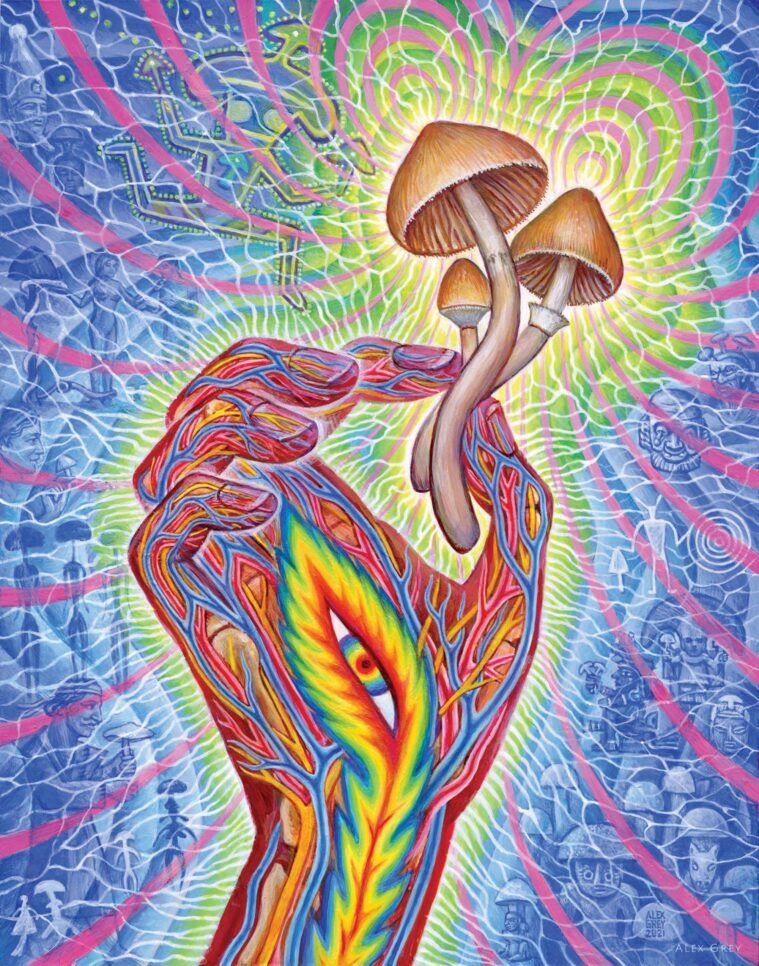
How would your art and lives be different if you’d never taken psychedelics?
Alex: It cured my suicidal ideation. Without meeting spirit, I don’t know if I’d be alive today.
Allyson: For three years, I took LSD with friends and alone – climbing a mountain, people watching, and on bicycle excursions. Every journey was evolutionary and self-revelatory. In 1971, I read the book “Be Here Now” by Ram Dass and tried taking LSD solo in a dark room. In that journey, I saw Secret Writing – the cryptic language of the divine. It transformed me and my artwork. Until I met Alex three years after, I dared not share the meaning of my secret body of art.
You frequently use the term “entheogen”…what is the origin of that term? Is it synonymous with psychedelic drugs, or is there a difference in its meaning?
Alex: “En” as a prefix means “in” or “embedded in.” The syllable “Theo” comes from the Greek word for God. “Gen” used as a suffix means, “that which produces.” Entheogen, therefore, could be defined as, “that which produces the effect of God consciousness.”
“Psyche” refers to the mind. “Delic” from the Greek “Delos,” means manifest or dilate, related to an experience. So, “psychedelic” could be defined as “manifest from the expansion of the mind.” We use both words, but Entheogen most articulately points to the spiritual influence of the sacrament.
Allyson – can your “secret writing” be translated and comprehended, or is it purely an abstract expression of imagination?
Allyson: Secret Language in my art is an ineffable and untranslatable language of creative expression coming directly from my personal vision. They were made visible to me in the psychedelic state. Their meaning comes from the divine, the force some call God.
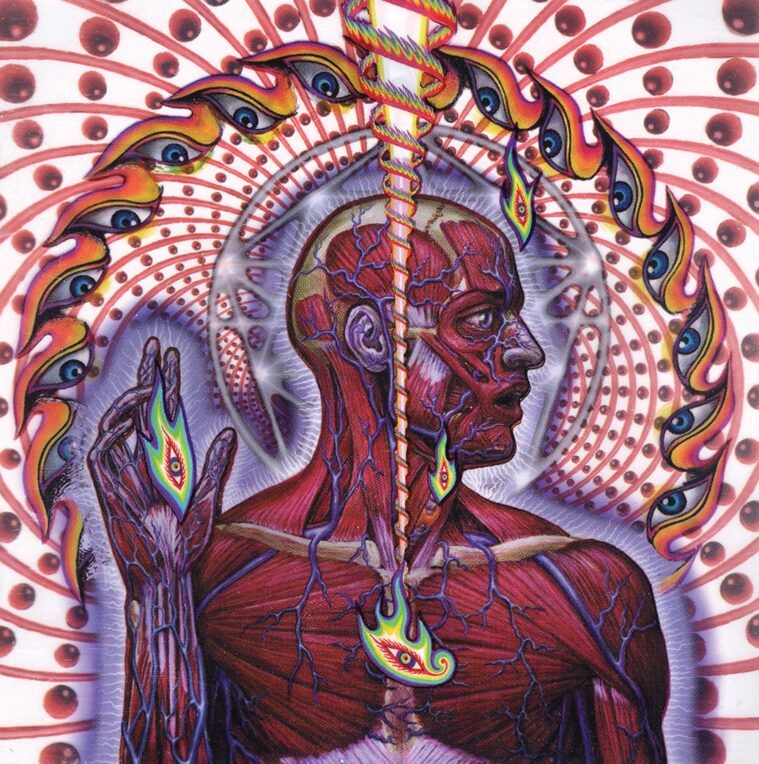
What does “God” mean to you?
Allyson: God is faceless. God is ineffable, beyond physicality or description – a force in all beings and things. Any guru will tell you that God is within.
Alex: God is an experience that, once known, cannot be unknown. God is beyond conceptions. The divine is a transcendental force animating all life and the creative intelligence that birthed the cosmos.
Is there one religious tradition you relate to most, and why?
Alex: Many creative people, when deep in their work, feel connected with spirit. Our work addressed the union of creativity and spirituality. Born into a family of Methodists, I saw Christ as my first spiritual friend. When I was nine, my parents turned their backs on the church in response to the racist hypocrisy they observed during the civil rights movement, but they never explained that to us kids until we were adults. After meeting Allyson, I began studying Tibetan Buddhism in the late ’70s – a connection that has strengthened for decades. Having studied the mystic traditions, I find connections between them all. Ken Wilber, the Integral Philosopher, has also influenced me deeply.
Allyson: Since Alex began studying Buddhism, I’ve learned and appreciated a great deal in the wisdom of that tradition. Decades ago, we had the privilege of studying with the Dalai Lama at Harvard Divinity School. It is our regular practice to read to each other from Tibetan Buddhist texts each morning after yoga and meditation.
But I grew up in the Jewish tradition, which most resonates with my psychedelic experience. God’s message is transferred through writing in all the major religions, and in Judaism – where graven imagery of God is prohibited – the Torah and libraries of commentary are the most revered works of influence.
In your opinion, which is the more powerful/effective tool in humanity’s journey toward enlightenment—psychedelics, religion, or art?
Alex: Meditation is the royal road toward spirit. Psychedelics can catalyze a mystical experience, the foundation of all religions. Psychedelics have encouraged many to take on contemplative practices. Art can be one of those practices.
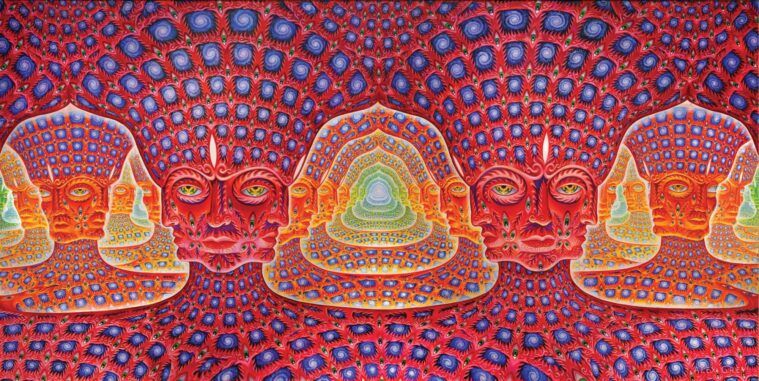
You host many different spiritual ceremonies, whether they be online, at events, or on your property. Can you tell us about some of the more significant ones?
Alex: A shaman, Alex Stark, wanted to help us create the Chapel of Sacred Mirrors and advised us to start Full Moon Ceremonies and invite the community who felt called to this project. With his assistance, we held CoSM’s first Full Moon ceremony in our Brooklyn home on January 16th, 2003. On Easter Sunday, April 20, 2003, following our first public Full Moon on April 16th, an NYC landlord offered us a raw loft space to hold ceremonies and events. After investing in building the space, on the fourth floor of 542 W. 27th St., CoSM opened in its first location outside of our home. A true miracle. This location was becoming the Chelsea Art Gallery and nightclub district of New York. Amazing teachers shared wisdom there and the community grew. One of the first Iboga Conferences with Howard Lotsof was held there. Deepak Choprah visited.
Five years later, CoSM bought and moved to an old retreat center to build an enduring sanctuary. When this publication is released, CoSM will have hosted 244 consecutive Full Moon Ceremonies, all for the purpose of activating the creative force in everyone and praying for the building of a contemporary sacred space that embraces universal spirituality. Celebrations based on celestial events, like the Full Moon, the New Moon, Equinoxes, and Solstices, are shared by every human on Earth. Without conflicting views, celestial events are evidence of our global unity.
Art Church is now a live online event for CoSM Members held every New Moon when we gather on Zoom to make art together and discuss our lives around a theme. July’s theme is Sacred Geometry and August is traditionally the month we talk about Community. Before Covid, we featured music, dance, a fire circle, and many workshops.
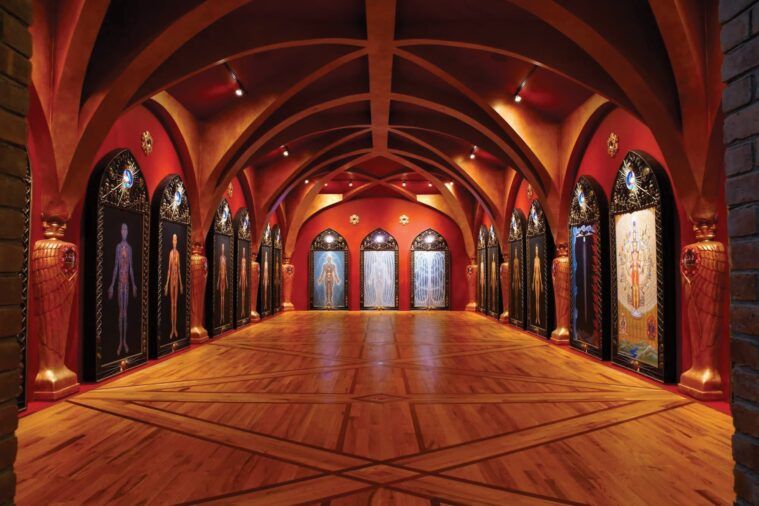
How did you first conceive of the Chapel of Sacred Mirrors?
Allyson: The Chapel of Sacred Mirrors (CoSM) was inspired by a 1978 collaborative performance called Life Energy that included Alex’s life-sized ink drawings of the human anatomy. One drawing represented the physical anatomy by portraying the nervous system. The other drawing visioned the metaphysical anatomy of chakras, acupuncture meridians, and auras. After noticing the popularity of these charts during the performance, I suggested painting an entire series of life-sized paintings that would include the systems of the human body, mind, and spirit. More than ten years later, nineteen paintings and two etched mirrors comprised the Sacred Mirrors, a name also suggested by Allyson.
Alex: In 1984, at a Chicago exhibit of the series, a collector became interested in purchasing eighteen of the Sacred Mirrors before the entire series was complete. Soon thereafter, visiting our Brooklyn studio, we signed a contract with that collector, selling the series for more money than we’d ever been offered. The collector also gifted us two doses of MDMA, then legal, that he had been prescribed to treat anxiety. Three days later, took MDMA for the first time. Within that experience, we envisioned the series as an installation that included highly sculpted pictorial frames. Simultaneously, we saw this as a public psychedelic space. Selling them would make that vision impossible and we begged off on our contract. Within months we began sculpting and casting twenty-one, ten-and-a-half-foot frames for the paintings.
In 1985, the Sacred Mirrors had their first exhibition with the sculpted frames, at the New Museum in New York City. Shown widely for decades, the Chapel of Sacred Mirrors (CoSM) became a non-profit organization in 1996 with the following mission: “To build an enduring sanctuary of visionary art to uplift a global community.”
In 2002, after many presentations of our vision, a shaman advised us to begin Full Moon ceremonies and pray with supportive friends for the advancement of that mission. The first CoSM Full Moon was held in our Brooklyn loft in January 2003 and has been an unbroken chain of 244 Full Moon ceremonies by the time of this publication, eighteen years, come January 2023.
In 1984, a collector who was interested in purchasing the series gifted us two doses of MDMA, then legal. Three days later, we took MDMA for the first time and envisioned the series as an installation that included sculpted pictorial frames in a public psychedelic space. Within months we began sculpting and casting the 21, 10.5-foot frames for the paintings that became the Sacred Mirrors.
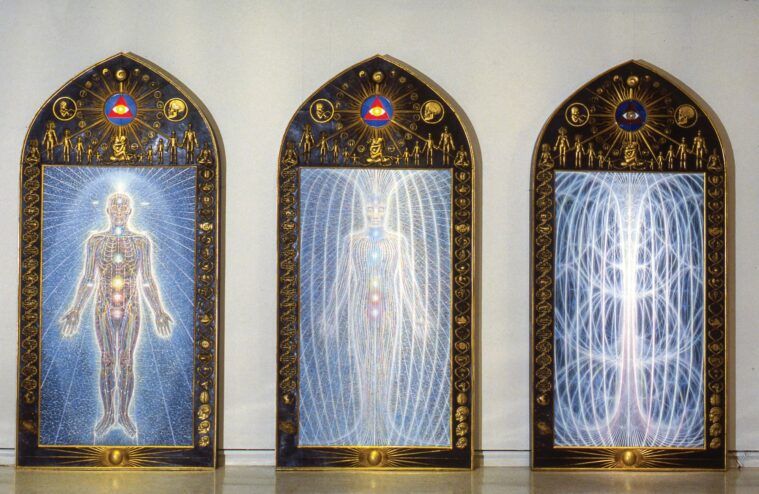
When did the “Chapel” part enter the picture?
Allyson: On Easter morning, April 2003, after only four Full Moon celebrations, an NYC landlord offered us a raw industrial space on 27th St. to hold the fast-growing performative Full Moons.
By August 2004, the Manhattan spiritual creative center was opened CoSM NYC offered a permanent collection featuring the Chapel of Sacred Mirrors and many beloved works by Alex Grey, some by Allyson Grey. CoSM also hosted the second gallery in the vast 12,000-foot space, called MicroCoSM, exhibiting a rotating exhibit of works by the global Visionary Art Community. A dance studio at this spiritual creative center was named CoSMosis, and served as an events space for monthly Entheocentric Salons and many programs and workshops. It was the home of the first CoSM Shop selling creative gifts and altar objects with proceeds supporting the center. CoSM offices and shipping for the online store had a home there. Soon, five nightclubs shared the building and the street, once filled with scrap yards and abandoned buildings, became thick with galleries restaurants, and clubs.
Throughout our five-year lease in the Big Apple, gatherings, workshops, conferences, and celebrations fulfilled CoSM’s mission. Within our residence, a new landlord threatened to quadruple our affordable rent. We realized that our “enduring sanctuary” needed a secure home and would be better suited to a tranquil environment in nature. Alex found the perfect location on findthedivine.com, a small retreat center on forty wooded acres, 65 miles up the Hudson River from Manhattan, walking distance from a stop on the Metro North train from NYC’s Grand Central Station.
How has CoSm changed since its moved upstate?
Allyson: Because CoSM NYC had become a space for weddings, baby blessings, memorials, spiritual workshops, and educational events, we were encouraged and supported by wise friends to become an inter-spiritual, church. In late 2008, overlapping our move from the city, the Church of Sacred Mirrors was sanctioned by the IRS, the NY State Attorney General, and eventually by the Town of Wappinger. The property, purchased from the United Church of Christ, came with six buildings and a barn, all in serious need of rehabilitation.
CoSM has restored now eight buildings. An 1862, ten-bedroom house accommodates guests plus five media and management offices. There is housing for staff and an entire house converted for shipping (The Ship). The Classroom is now being rebuilt and Entheon, the sanctuary of Vision Art, is soon to open. To create Entheon, a carriage house was transformed into a three-story, 12,000-square-foot exhibition space, hosting the permanent collection, including the Chapel of Sacred Mirrors, galleries for the work of both artist founders, and the All-One Gallery that will host an annually rotating exhibit of the International Visionary Art movement.
CoSM has been officially closed since March 13th, 2020, when Covid suspended all hospitality and onsite programs. CoSM.tv, our YouTube channel, has continued presenting Full Moon ceremonies online, as well as interviews and special offerings — over 100 episodes. During that pandemic, the outreach to a global community has swelled to serve a global community and more than tripled CoSM’s membership. Galleries in Entheon are still being prepared for visitors. The final major improvement to Entheon required before opening is now in progress — the emergency water system to activate the sprinklers for fire safety. With that completion, the Town of Wappinger will grant Entheon a Certificate of Occupancy needed before we can announce the opening to all. It will be a soft opening. Members are welcome to a tour of Entheon scheduled for the August Full Moon (Saturday, August 13th).
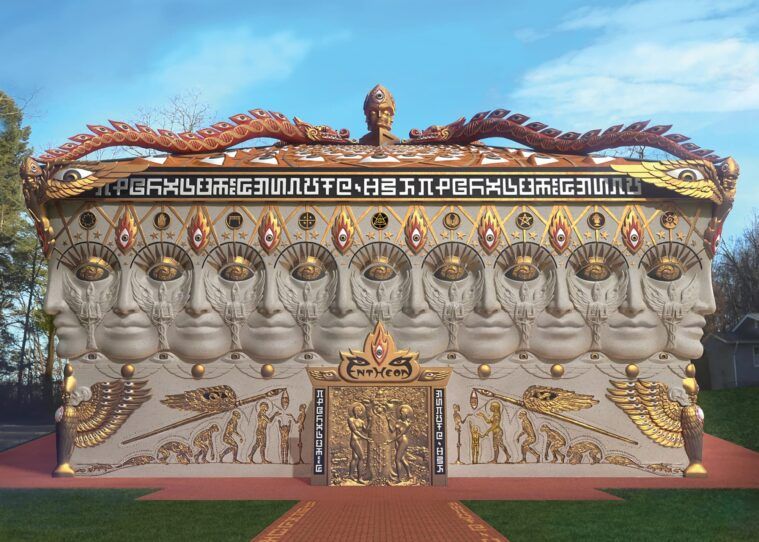
In recent years, it feels like dark forces have been ascendant in this country and around the world. What, if anything, can we do to reverse this tide and move things back toward the light?
Allyson: As darkness gets darker, light appears brighter. There is more inter-spirituality and tolerance in the world today. Not until 1965 did intermarriage between blacks and whites become legal throughout the United States. That aligns with the psychedelic revolution. Although no Equal Rights Amendment has ever passed in the U.S. government to guarantee fair wages for the “second sex,” women are accepted into most educational institutions and in more job markets than ever before. As a child, I saw public facilities had signs prohibiting black from drinking at water fountains, bathrooms, and pools. I remember signs on public facilities that said “No Dog. No Jew.” When you think that the world has never been worse off, think of the Holocaust. Two-thirds of the population of England died in The Black Plague.
What we can do is be a beacon of light. Creativity and compassion can make our tiny corner of the universe a better place by being the best we can be, through eco-consciousness and our acceptance of differences. Be kind, and if only for your own benefit, love everyone.

